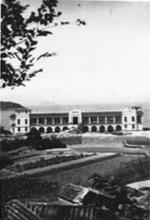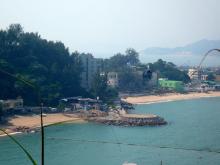Aw Par Hospital / St. John Hospital, Cheung Chau [1934- ]
Primary tabs
Submitted by David on Thu, 2015-10-01 20:25
Current condition:
In use
Date Place completed:
c.1934-01-01 (Month, Day are approximate)
Tags:





Comments
St. John Hospital
With a generous donation from Mr. Aw Boon-haw (Tiger Balm King), the magnificent two-storied Aw Par Hospital building was formally opened on 21 November 1934. HK Daily Press 22 November 1934 refers.
As the hospital was run and managed by the St. John Ambulance Brigade, it appears in later years that it was renamed as St. John Hospital. A third storey would be added.
Heritage appraisal
Notes from the AAB's appraisal of historic building number 611, available online at http://www.aab.gov.hk/historicbuilding/en/611_Appraisal_En.pdf :
Historic Building Appraisal
St. John Hospital (Haw Par Hospital)
Cheung Chau Hospital Road, Cheung Chau
Historical Interest
From the words carved on the tablet hung above the entrance, as follows, the linkages of this hospital with the Aw Brothers and St. John Ambulance Association can be easily understood.
St. John Ambulance Association
Haw Par Hospital
Donated by Mr. Aw Boon Haw and Mr. Aw Boon Par
The hospital was originally named in English as Haw Par Hospital (‘Haw’ meaning ‘tiger’ and ‘Par’ meaning ‘leopard’ – thus literally, 虎豹醫院), but its Chinese name that appears on the tablet is 長洲醫院 (Cheung Chau Hospital). The hospital is also known as St. John Hospital (聖約翰醫院) as it was built for the St. John Ambulance Association (聖約翰救傷隊).
Construction work on the hospital began in 1932 and was completed in 1934. It was funded by a generous donation from two Burmese Chinese brothers, Mr. Aw Boon-haw (胡文虎) and Mr. Aw Boon-par (胡文豹), who started a medical business in Rangoon (仰光) in 1900 and named their company as Haw Par Brothers in 1932.
In the early days, there was no properly equipped hospital in Cheung Chau, though there was a hospital, namely The Cheung Chau Fong Bin Hospital (長洲方便醫院) practicing Chinese medical treatment. To cope with the increasing demand of the growing population, construction of a well-equipped hospital was urgently needed.
The hospital was originally built as a missionary hospital. But after the Second World War, it was by agreement staffed and maintained by the Government to serve as a rural hospital for the local community and as a tuberculosis sanatorium for light or convalescent cases. Since the closure of The Cheung Chau Fong Bin Hospital in 1988, it remains the only hospital in Cheung Chau. It is now a member of Hong Kong East Cluster (港島東聯網) under the administration of the Hospital Authority.
Architectural Merit
The Hospital is a three-storey building built to a symmetrical E-shaped plan. The architectural style is Neo-Classical with Chinese influence. The walls are rendered and painted with horizontal band courses at each storey level. Windows are regularly spaced. The façades feature arched and colonnaded verandahs some open and some enclosed with glazing or blocked up. Square columns with stylised capitals and chequered patterned balustrades are strongly featured. The roof is flat with a plain parapet set above a projecting moulded cornice. Chinese influence can be seen in the ‘moon-gate’ door at the entrance hall, which also features columns decorated with dougong style brackets.
Rarity, Built Heritage Value & Authenticity
This style of architecture is quite rare especially in the rural environment of Cheung Chau. Now over 70 years old, the Hospital has important built heritage value. Many refurbishment projects have been undertaken at the Hospital over the years including replacement of internal finishes, removal of internal walls, erection of new partitions, installation of window mounted room coolers, and replacement of windows, etc. An Outpatients’ Clinic was built next to the Hospital in 1974.
Social Value & Local Interest
The social value of the Hospital lies in the role it has played in the field of medical services. As well as having a clinic for outpatients, the Hospital runs general and specialist clinics, has 93 beds, and provides a round-the-clock accident and emergency service. Providing important Western medical services to the community means that the Hospital is of considerable local interest to the residents of Cheung Chau.
Group Value
It is physically close to other graded buildings, namely Cheung Chau Government Secondary School, Cheung Chau Police Station (長洲警署) and The Cheung Chau Fong Bin Hospital, to which St John Hospital once gave funding.
Adaptive Re-use
As the Hospital, which is the only one on Cheung Chau, is unlikely to close down the question of adaptive re-use does not really arise.
Indoors boundary stone
Extension to St. John Hospital
HK Daily Press 10 December 1938.
The extension to Cheung Chau Haw Par Hospital was recently completed. A new floor containing two wards was added through a generous donation by Aw Boon-haw and Aw Boon-par.
Boundary Stone in St. John Hospital
The Cheung Chau (Residence) Ordinance came into effect in 1919. Whilst looking for information on St. John Hospital from 1930s, I noted the site of St. John Hospital had been previously a Chinese tenement with 2 storeys. I guess the boundary stone would have been originally placed in the grounds of the tenement building to demarcate the boundary of the European reservation. As the Ordinance was in force at the time St. John Hospital was being constructed, the boundary stone would have been required to be put in place at or near the original location to mark the reservation boundary line.
BS stones & 1938 CC map .....Mistakes here & there..
On this map Hospital stone marked as #1 but found to be #14,
Peak Rd. near Nam She Tong as #2, but found to be #13
on the hillet of Church of Christ in China as #3, ........to be #12.....(this one is the next search target)
At Tin Fok area, #4............expect to be found as BS #11, Likely in the yard of Tsu Yuen next to Tin Fok Pavilion.
#5......(map-maker shows frustration).....he could'nt pick any around the Tai Shek Hau area....Sorry!
#6.....just north-west of Houses# 30 & #29..........Yet to be confirmed ( expected to be #9)
the rest .....map-maker doesn't care of their numbers. No telling on the map!
BTY the Carving ' OAO ce' was supposed to be ' ORD ce' as the abbreviation of 'Ordinance'. And the Stonecutters just not paid full attention about the differences.
Mistakes here & there.....
Tung
Boundary Stone 1
Hi There,
I remember there was much a stirr when they found #1 on the coast line within Sai Yuen the other day. The news said the undertaker of Sai Yuen would restore the stone and put it on exhibition somewhere close to its original location.
Pity we likely have to pay to entre these days.
T
Further reasoning....
Glad to learn about the BS #1 was at the Sai Wan area, it also makes good sense to the colonial department.
In 1919, airplanes already became very important means for rapid travel or transport. So when they, the international travelers, fly-in over the Cheung Chau NDB air traffic Corridor, it makes good sense for them to approach the #1 Stone ( Sai Wan ), then progressively proceed towards the last one ----the #14 stone ( before any building was being built or later by the Building near the beachhead at the East-end of Tung Wan )
By 1938, the St John Hospital was a new thing. And the Stone was 'lost' in sight, so it was easy to label its # wrongly as most other BS stones were hidden from community at large.
Only a few BS stones are along the ER line, probably 2/3 are not as the 1938 map revealed
Tung.
Walking BS Stones?
After Flag Change of 1997, they might be allowed to 'walk around' to give way for various reasons....since residents of CC need to build much more houses.
Some of the BSs may be required to take a walk.
Why not?
Tung